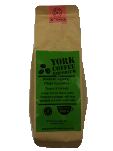York Coffee Emporium Sumatran Gegarang Coffee
 The first thing we noticed with this one is the beans are big, dusty and hard as nails. A bit like the mother in law. Arf. By which we mean even though we ground these things to hell and back, there were still chunks floating around in our grinder. Still, we persevered and ground them to dust in the end. This coffee is a nice and light tasting one – it looks light in the cup too. We did have a tendency to overdo it though just to try and wring a bit more taste out of it. But it didn’t really work – it hits a peak and then it tends to just overload on a metallic aftertaste. Even so, it’s still tasty and does have a bit of a twang – slightly citrus but not overkill. It’s quirky enough to give to anyone and should raise a smile at your dinner party. 8/10
The first thing we noticed with this one is the beans are big, dusty and hard as nails. A bit like the mother in law. Arf. By which we mean even though we ground these things to hell and back, there were still chunks floating around in our grinder. Still, we persevered and ground them to dust in the end. This coffee is a nice and light tasting one – it looks light in the cup too. We did have a tendency to overdo it though just to try and wring a bit more taste out of it. But it didn’t really work – it hits a peak and then it tends to just overload on a metallic aftertaste. Even so, it’s still tasty and does have a bit of a twang – slightly citrus but not overkill. It’s quirky enough to give to anyone and should raise a smile at your dinner party. 8/10
"Coffees from Sumatra are known for smooth, sweet body that is balanced and intense. This Gegarang is deep and full bodied with a tangerine sweetness layered with heavy chocolate. We let this one rest for a few days after roasting to ensure the flavours are allowed to develop. The history of Geragang village was part of the Indonesian transmigration program that brought many Javanese people initially to the northern region of Aceh around Lake Tawar to reduce the over population of Java during the 1980s. The village has 46 members who grow their organic coffee on plots of around one hectare at an altitude of 1,500 to 1,600 metres above sea level; other crops include potatoes and beans. Gegarang village is only 4 kilometres from Jagong and is situated between Takengon and Lake Tawar. Coffee was planted in Sumatra by Dutch colonialists in the late 1600s under the guidance of the Dutch East India Trading Company (VOC). Between 1602 and 1796 the VOC sent almost a million Europeans to work in the Asia trade on 4,785 ships and netted for their efforts more than 2.5 million tonnes of Asian goods. With Europe’s ever increasing thirst for coffee at that time this commodity played an important role in the trade of Indonesia, as indeed it does today. Following early success in Java coffee was then introduced to Sumatra, initially to the northern region of Aceh around Lake Tawar. Sumatran coffees are mainly produced by a unique semi-washed process which is sometimes described as "wet-hulled" and is known locally as Giling Basah. In this process the coffee is picked, machine pulped (usually on the individual small holding) and then partly sun dried. The parchment is then removed revealing a whitish coloured, swollen green bean. The drying is then completed on the patio where the seed quickly turns to a dark green colour unique to Sumatra. This method brings about more body and often more of the character that makes Indonesians so unique and recognisable with flavours ranging from deep chocolate to tangerine funk. There are around 68,000 hectares of coffee cultivated in Aceh by 65,000 farmers, which makes the average farm about 1 hectare. Aceh is a well-forested region with as many as 300 trees per hectare; approximately 90% of the production in Aceh is organic. Altitude in the cultivated area of Aceh ranges from 800 to 1,600meters and coffee is harvested between November and May. The coffee varietals are mainly bourbon with some P88 and a little catimore, all of which is grown organically. The coffee is semi washed and wet-hulled, a process that involves the part-drying of freshly pulped beans before removing the parchment then allowing the swollen and ‘blanched’ beans to be sundried to a deep green colour. A very deep and full bodied coffee is the result with a tangerine sweetness lacing heavy chocolate. The harvest takes place between October and July and the coffee is stored in GrainPro sacks for shelf life longevity"
- Log in to post comments
